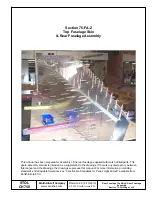
THANK YOU
EN
01
T
hank you for choosing to fly Ozone. As a team of paraglding and paramotoring enthusiasts, Ozone’s
mission is to build agile wings of the highest quality with cutting edge designs, high performance and
maximum security.
Confidence and belief in your paraglider is a far greater asset than any small gains in performance - ask any
of the Ozone pilots on your local hills, or those who have taken our gliders on ground-breaking adventures
or stood on podiums around the world. All our research and development is concentrated on the True
Performance philosphy - creating the best handling/performance characteristics possible with optimum
levels of security throughout the speed range.
Our development team is based in the south of France. This area - which includes the sites of Gourdon,
Monaco and Col de Bleyne - guarantees us more than 300 flyable days per year, this is a great asset in the
development of the Ozone range.
As pilots we fully understand just how big an investment a new paraglider is. We know that quality and
value for money are essential considerations when choosing a new wing, so to keep costs low and quality
high we manufacture all of our products in our own production facility. During production our wings undergo
numerous rigorous quality control checks that are fully traceable, this way we can guarantee that all of our
paragliders meet the same high standards.
It is essential that you read this manual before flying your paraglider for the first time. The manual will
help you get the most out of your new wing, it details information about the design, tips and advice on how
best to use it and how to care for your wing to ensure it has a long life and retains a high resale value. For
the latest updates, including all technical datas please refer to the online version. This can be found on the
product’s page on at www.flyozone.com
If you need any further information about any of our products please check flyozone.com or contact your
local dealer, school or any of us here at Ozone.
Safe Flying!
Team Ozone






























